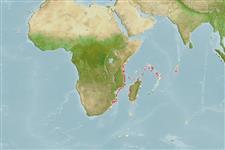>
Eupercaria/misc (Various families in series Eupercaria) >
Cepolidae (Bandfishes) > Owstoniinae
Etymology: Owstonia: Named for Alan Owston (1853‒1915), an amateur naturalist, yachtsman and collector of Asian wildlife, notably fishes from Japan and China.; simotera: Name from Latin 'simoter' for snub-nosed..
More on author: Smith.
Environment: milieu / climate zone / depth range / distribution range
Ecologia
marino batidemersale; distribuzione batimetrica 450 - 549 m (Ref. 119093). Deep-water
Western Indian Ocean: southern Mozambique.
Size / Peso / Age
Maturity: Lm ? range ? - ? cm
Max length : 29.8 cm SL maschio/sesso non determinato; (Ref. 119093)
Short description
Chiavi di identificazione | Morfologia | Morfometria
Spine dorsali (totale) : 3; Raggi dorsali molli (totale) : 21; Spine anali: 1; Raggi anali molli: 14. Body and fins red or crimson in color.
Life cycle and mating behavior
Maturities | Riproduzione | Spawnings | Egg(s) | Fecundities | Larve
Smith-Vaniz, W.F. and G.D. Johnson, 2016. Hidden diversity in deep-water bandfishes: review of Owstonia with descriptions of twenty-one new species (Teleostei: Cepolidae: Owstoniinae). Zootaxa 4187(1):1-103. (Ref. 119093)
IUCN Red List Status (Ref. 130435)
Threat to humans
Harmless
Human uses
Strumenti
Special reports
Download XML
Fonti Internet
Estimates based on models
Preferred temperature (Ref.
123201): 10.4 - 11.3, mean 10.8 °C (based on 3 cells).
Phylogenetic diversity index (Ref.
82804): PD
50 = 0.5000 [Uniqueness, from 0.5 = low to 2.0 = high].
Bayesian length-weight: a=0.00389 (0.00180 - 0.00842), b=3.12 (2.94 - 3.30), in cm total length, based on all LWR estimates for this body shape (Ref.
93245).
Trophic level (Ref.
69278): 3.4 ±0.4 se; based on size and trophs of closest relatives
Resilienza (Ref.
120179): Medio, tempo minimo di raddoppiamento della popolazione 1.4 - 4.4 anni (Preliminary K or Fecundity.).
Fishing Vulnerability (Ref.
59153): Low to moderate vulnerability (26 of 100).
